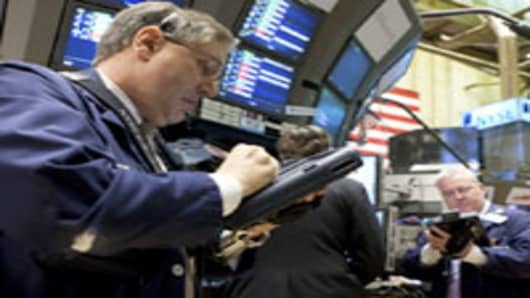After waiting months for a pullback from the stunning five-month stock rally, Wall Street may have met its match Monday.
Stocks went into a tailspinthat ostensibly came after disappointing GDP numbers out of Japan.
But the real roots of the downturn seem to run deeper. Continued weakness from the consumer, along with other signs, have market pros convinced that stocks have begun a correction—typically defined as a drop of at least 10 percent.
The only questions seemed to be how deep and how long.
"The market seems to be second-guessing its recovery thesis—rightfully so," said Chip Hanlon, president of Delta Global Advisors in Huntington Beach, Calif. "If the market wants to focus on the consumer, it's going to have a hard time going higher."
Yet he thinks that even a sharp correction might still leave the markets in decent shape as the government continues to spend aggressively to spur economic growth.
"Could we see a 700- to 1,000-point selloff? We could have one and the bulls could still be saying it's a bull market," he said. "It would be a very normal correction in my book."
While Hanlon attributed the looming correction primarily to consumer issues, there were a host of other reasons cited by other analysts.
1) Earnings Hangover
While a wildly successful earnings season—at least in terms of comparison to Wall Street estimates—helped propel the 50 percent stocks rally off the March lows, the winding down of earnings could have the opposite effect.
"Earnings were good because they were cutting costs. They weren't good because there wasn't any growth," Lutz said. "Now that we're through earnings, people are saying, 'Where's the growth?'"
As a result of the cost cuts, David Kotok, chairman of Cumberland Advisors, expects manufacturing data points to continue to rise, resulting in "strong single-digit" growth numbers for gross domestic product over the next several quarters.
The trouble, he and others say, could be over the horizon.
"I'm in the double-dip camp," Kotok told CNBC. "But the second half of the 'W' is way out in front of us."
2) China Downturn
Others cite trouble in China, which had been looked to by many as the nation to lead the world out of recession. The hopes were that China's consumers would begin to demand products from other countries, a trend that in turn would spur growth for multinational companies.
But the Chinese markets have been pounded over the past couple of weeks, with stocks there dropping about 18 percent.
"Since China was leadership during both the bear market decline and the recovery, this could very well be the 'canary in the coal mine,' " Bank of America-Merrill Lynch technical analyst Maryann Bartels said in a research note. "This has the potential to signal a deeper correction for China and is a bearish indicator for the global equity market rally."
BofA-Merrill Lynch has been predicting a correction in the 15 percent range that the firm says could reach as high as 30 percent.
3) Inside Dope
Closer to home, those looking for a correction also are watching selling by traders inside companies.
Insiders have been selling at a rate 28 times more than they have purchased in the last month, said Dave Lutz, managing director of trading at Stifel Nicolaus in Baltimore.
"You have insiders selling to the crowd," Lutz said. "You never want to be investing with the crowd."
With that bearish signal in place, Lutz said he's anticipating a fairly quick and steep drop—a likely 10 percent pullback that would entail a move to 950 on the Standard & Poor's 500 within the next couple of days.
As such, he's advising investors to sell into the coming storm.
Not everyone agrees.
Bruce McCain, head of strategy at Key Private Bank, predicts a correction of about 10 percent but doesn't think investors should rein in positions.
"We feel pretty comfortable telling our clients to make sure they're fully invested," he said.
4) Beware Lack of Buyers
Yet at the root of the market's problems remains consumer weakness, and it's hard to imagine a full-fledged recovery without a change.
Buyers, as in consumers, are likely to remain scarce. With unemployment continuing to climb and uncertainty hanging on the horizon, savings rates are expected to escalate, forcing companies to continue cutting costs to boost their bottom lines.
"As long as the consumer, particularly in the United States, is going to have a rising savings rate, have to recovery from a financial crisis, has had a loss of wealth and a decline in housing values, all the things we know, the consumption portion of the US economy will diminish," Kotok said.
"And that means savings higher, (consuming) less, and we will have a very tepid recovery."
The spring-summer rally was built on government spending, not growth, making a recovery precarious, Hanlon added.
He said that the coming days are likely to see a temporary strengthening in the dollar as a safe haven while the global markets correct, and is advising investors looking to raise cash to sell stock in foreign companies.
"It's a terribly unhealthy foundation upon which this latest rally was built, and it does nothing to solve our longer-term challenges of government overspending," he said. "Washington's trying to encourage us to do more of exactly what got us into this mess in the first place. That can't be a good longer-term solution."




